Star Trek III: The Search for Spock (1984)
Genre Sci-fi adventure
Country USA
Director Leonard Nimoy
Screenplay Harve Bennett; based on Star Trek created by Gene Roddenberry
Running time 104 mins | Colour Movielab | Widescreen Panavision
The 1982 film Star Trek II: The Wrath of Khan created a major problem for the Star Trek film series: the death of one of its main characters, Mr Spock. Whether Star Trek would, could or should have continued without Spock is debatable.
Fortunately, Leonard Nimoy had second thoughts about leaving Star Trek and the makers inserted a coda into the film suggesting that his character might indeed return. A photon torpedo tube used as Spock's coffin was shown having safely landed on the Genesis planet in the final scene of Star Trek II. So could Spock still be alive by some miracle?
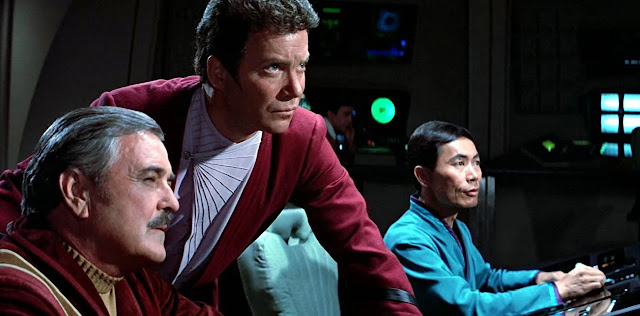 |
| Scotty (James Doohan), Kirk (William Shatner) and Sulu (George Takei) |
Star Trek III: The Search for Spock begins with a prologue reminding the audience of the events of Star Trek II, specifically Spock's death in the radiation chamber of the starship Enterprise.
Back in the present, and Kirk (William Shatner) is moping around the ship, keenly aware of the absence of his old friend, while Dr. McCoy (DeForest Kelley) is acting very strangely. He breaks into Spock's quarters, starts to speak with Spock's voice and earnestly asks Kirk why he has left him behind on the Genesis planet.
The Enterprise returns to Earth where the crew learn that the ship is to be decommissioned. The future belongs to ships with transwarp drive, like the new Excelsior, currently in space dock alongside the Enterprise. Chief Engineer Scott (James Doohan) is reassigned to the new ship, while the other regulars go on leave. On his return to Earth, Dr. McCoy tries to hire unsavoury aliens to take him illegally to the Genesis planet, which has now been placed in a restricted zone.
Meanwhile, Kirk is contacted by Spock's father Sarek (Mark Lenard) who tells him that he must go to Vulcan to lay Spock's spirit to rest. Sarek assumes that Spock mind-melded with Kirk before he died, so that his spirit would not be lost and could then be returned to his home planet. Kirk assures him that he didn't. But when they review security camera footage from the Enterprise, they discover that Spock did in fact mind-meld with someone before entering the radiation chamber; Dr. McCoy.
Kirk determines to lead his regular crew, Scotty, Sulu (George Takei), Chekov (Walter Koenig) and Uhura (Nichelle Nichols) to steal the Enterprise and fly it and Dr. McCoy to the Genesis planet to retrieve Spock's body.
On the planet itself, Kirk's son David (Merritt Butrick) and Lieutenant Saavik (Robin Curtis) have discovered that the body has been miraculously regenerated by the remarkable planet and Spock is now alive as a young Vulcan boy, albeit ageing rapidly. The planet itself, though, has proved to be unstable and is beginning to crumble and destruct when a ruthless Klingon Captain, Kruge (Christopher Lloyd), arrives intent on gaining control of the Genesis device for the Klingons.
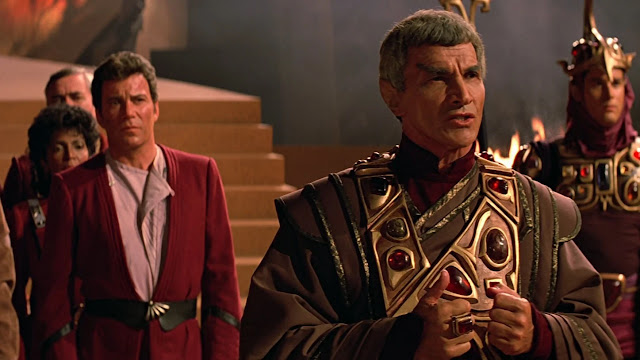 |
| Kirk and crew with Sarek (Mark Lenard) on Vulcan |
Star Trek III: The Search for Spock is inevitably a letdown after Star Trek II: The Wrath of Khan. The latter was not just a good Star Trek film, but a good film in its own right. But it did leave a difficult problem for the series to resolve and Star Trek III's job is just to fix that problem as best it can.
Having decided to leave the series and the character of Spock once and for all, Leonard Nimoy evidently had a change of heart. Probably, he grew bored making Star Trek: The Motion Picture anyway and didn't see much future for his character. But Star Trek II obviously changed things, breathing new life into the film series. The deal for Nimoy to return was sweetened by the offer of the director's chair on this film.
One of the guiding lights behind the Star Trek film series, from the second film onwards, was former TV producer Harve Bennett, who had helped to develop the story and acted as executive producer on The Wrath of Khan. For Star Trek III he took a more hands-on role, both producing the film and writing the script.
Bennett's script solves the problem of Spock's death with a little ingenuity and a lot of chutzpah. Spock's coffin not only "soft lands" on the planet because its surface is soft where it was still forming, but the properties of this new environment are so miraculous that his body is also revived from the dead. Fortunately, Spock put his memories into Dr. McCoy's convenient brain, so that they could be retrieved later.
You might think that if it's so important for Spock's spirit to be saved before he dies, then he would at least have mentioned this to Kirk, or to someone else on the Enterprise, just in case he did die on one of their missions. Then again, wouldn't Lieutenant Saavik know all about this anyway, being a Vulcan herself?
But there's little point complaining about this. Either you accept that the film is going to bring Spock back or you don't. The film's job is just to make this experience as painless as possible, and it mostly manages to do that with enough confidence and dignity to get away with it - certainly more than something like the notorious "Spock's Brain" episode of the TV series.
This film's status as an addendum to The Wrath of Khan is emphasised by its repeated re-showing and restating of the exchange between Spock and Kirk in that film's finale, rehashing this famous scene to a degree that even J. J. Abrams might find excessive.
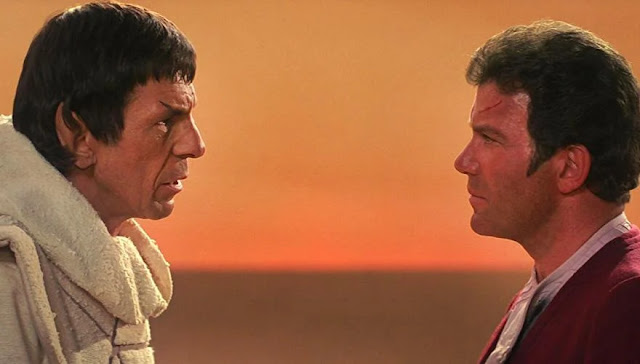 |
| Face to Face: Spock (Leonard Nimoy) and Kirk (William Shatner) |
Inventing a way for Spock to be returned from the dead evidently exhausted Harve Bennett's imagination, as the film lacks any interesting ideas elsewhere. The bar scene with aliens on Earth seems like a low budget retread of Star Wars' famous cantina scene and James Horner even supplies some similar-sounding background music, akin to John Williams's second, more chilled cantina theme in that film.
Plenty of other elements strain credibility, like how Saavik knows that their starship has been destroyed by an enemy attack just because she couldn't raise it on the radio. Or why the Enterprise normally has such a huge crew when it apparently needs only six people to fly it and take it into action against a Klingon warship in this film.
The film's fight scenes could be better staged and a sequence where the slight George Takei as Sulu easily beats up a security guard, who has just been established as being much bigger than he is, borders on the silly.
The film does continue the second film's acknowledgement of the ageing of the crew. In that film Kirk tells McCoy that "Galloping around the cosmos is a game for the young". To which Uhura indignantly replies "Now what is that supposed to mean?"
But whereas that film saw ageing as something to guard against, here it is almost seen as a positive. The older crew repeatedly outwit the callow young whippersnappers of Star Fleet, with their lack of experience and their flashy new ship the Excelsior. Even chief engineer Scotty is now bemoaning these advanced new star ships and their new-fangled technologies. This is quite a turnaround for a series originally predicated on optimistic techno-futurism.
Star Trek III not only reverses the death of Spock, but it also closes off other story possibilities from the previous film, so that the series can move on once more. Carol Marcus, Kirk's former lover and a senior scientist on the Genesis project, is now absent, eliminating the possibility of a revived relationship. Their adult son David does appear and is again played by Merritt Butrick. He investigates the Genesis planet with Saavik, when they detect life signs emanating from the area where Spock's coffin is located.
The planet's unstable nature is revealed to be the result of David's corner-cutting, a trait that the script and the character of Saavik suggest is inherited from his father. Having only just been introduced in the previous film, when Klingons arrive on the planet looking for the secret of Genesis, David is dispatched from the series relatively nobly if rather unceremoniously.
The film is weakened by some odd casting choices, presumably made by Nimoy as director. Robin Curtis as Saavik is not very much like Kirstie Alley, who played the character in the previous film. The lack of resemblance is emphasised by the fact that she has long, dark, curly hair, which is allowed to sit loose, unlike Alley's version, whose hair was usually tied back in a businesslike fashion. With Kirstie Alley unavailable, it probably would have been better simply to replace her with a new character.
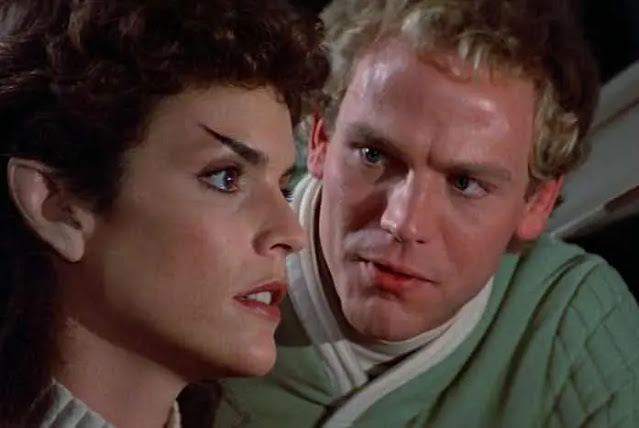 |
| David (Merritt Butrick) looks intently at Saavik (Robin Curtis). Maybe he's noticed that she now looks totally different. |
Christopher Lloyd, probably now best known as Doc Brown in the Back to the Future films, is an odd choice to play a Klingon captain and antagonist for Kirk, being principally a comic actor. Lloyd can do alien and eccentric, but he is not physically imposing and nor does he make for a natural villain. This casting, combined with the behaviour of the Klingons, leaves his performance teetering on the verge of parody.
The handling of the Klingons in this film generally is a little unsatisfactory, with the film repeatedly switching awkwardly between them using English when they talk to each other and using subtitled Klingon.
Despite the awful costumes of the first Star Trek film, Bob Fletcher somehow kept getting re-hired as Star Trek's costume designer and Star Trek III has some of the worst outfits seen in the film series. After the brief outbreak of sanity in Star Trek II, it's back to bad costume designs in Star Trek III, with Star Fleet security personnel wearing either camp, padded baseball caps or what looks like American football gear.
The off-duty clothes of the regulars mostly involve them wearing leather jackets, although in Chekov's case the jacket is better left on, as removing it reveals the film's most ludicrous costume. Bob Fletcher must have really taken against Walter Koenig, as he has dressed him in a ridiculous pink suit with a white frilled collar that makes him look as if he is auditioning for a remake of Pinnochio.
Star Trek III does have some additional nerdy interest for Trekkies as it sees the introduction of the Klingon "Bird of Prey" ship, with its distinctive, broad-winged profile and cloaking device. These ships would be used in the next three Star Trek films and also appear in the later TV series. More significantly, the film marks the momentous end of the original starship Enterprise, as it is destroyed in action against the Klingons.
Leonard Nimoy's direction on Star Trek III is more prosaic than Robert Wise's or Nicholas Meyer's on the previous two films. Nimoy has a more businesslike approach to directing, getting on with telling the story and not worrying too much about visual flourishes. The tone is also lighter than the more solemn and humourless first film and the more dramatic second one, despite the sometimes mystical subject matter, and the little bits of humour do help.
That the saturnine Nimoy would have a lighter touch and a taste for comedy comes as a surprise. But this was confirmed by his direction on the next film, Star Trek IV: The Voyage Home in 1986, as well as on a break from the Trek films to direct the comedy Three Men and a Baby the following year.
The Search for Spock had a different director of photography from The Wrath of Khan, Charles Correll, and it's noticeably brighter and crisper-looking than its predecessor, which is not altogether unwelcome. This is despite using the same cheaper Movielab colour of the previous film. The film does, though, more resemble an extended Star Trek episode and this is the first Star Trek film that feels like it's just part of an ongoing series.
That's probably appropriate in some ways, as this film settles the cast into a comfortable groove and reaffirms the Star Trek spin-off series as a relatively modest, but profitable one, for Paramount, shorn of any misplaced hopes that it might be the new Star Wars.
The Search for Spock was never going to be one of the best Star Trek films, but it did what it could with the situation it had inherited, and it could certainly have been far worse. Star Trek III was given the difficult task of reversing the conclusion and finale of the previous film in a way that doesn't completely negate or repudiate it, and it does manage to do that relatively satisfactorily - or at least satisfactorily enough for most fans.
Cast
William Shatner - Admiral KirkDeForest Kelley - Dr. McCoy
Producer Harve Bennett Cinematography Charles Correll Art director John E. Chilberg II Editor Robert F. Shugrue Music James Horner Costume designer Bob Fletcher Special effects Industrial Light and Magic
Production company Paramount Pictures; in association with Cinema Group Venture
Distributor Paramount Pictures
See also:
Star Trek: The Motion Picture (1979)
Star Trek II: The Wrath of Khan (1982)

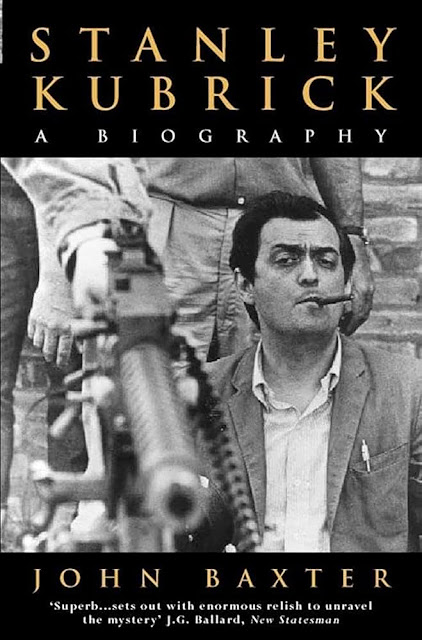
It suffers from being a bridge between two great movies. It has no beginning, it has no ending. And it's a little too male-forward for its own good. It needed Dr. Marcus, Spock's mom Amanda, and more Uhura. You are right about the costumes -- they are awful! (Chekov looks like a 17th century pilgrim). Plus, it has a huge plot hole: it's never really explained why they need Spock's body, and why they think the body survived the landing. However, I liked it despite its flaws. I love the somber score, and the ending is genuinely moving.
ReplyDeleteThere are definitely some plot holes, but I think a film like this you have to meet at least half-way. It only exists to bring Spock back, and you have to just go with that and cut it some slack.
DeleteI feel it does have an ending, because it revives Spock and reunites the whole crew. It then closes off other story possibilities from Star Trek II so the series can begin again (almost) anew. The next film ties up some plot points from this one, but it's still really a separate story.